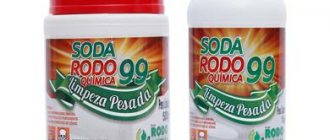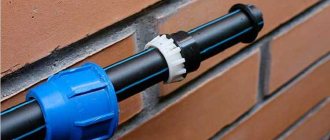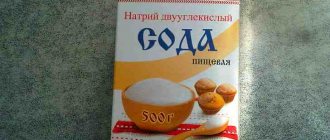The method of flushing drains in a house or apartment is selected depending on the origin of the problem. When rust and scale build up, acids are used; for old deposits, mechanical and hydraulic methods are used.
If the drains are simply clogged, caustic will help: the use of this drug for cleaning sewers is characterized by the simplicity of the technology. Knowing the features of cleaning, you can practice it regularly - and then the sewer pipes will not become clogged.
Characteristic properties of caustic soda
Caustic soda or caustic soda most often appears as a powder in the form of tiny crystals or solid, odorless, white granules. Due to their high hygroscopicity in air, they quickly dissolve, absorbing moisture. The substance dissolves perfectly in H2O, forming a liquid that is soapy to the touch and releasing a large amount of heat: 46 g of soda dissolves in 100 g at a temperature of 20 degrees Celsius.
Chemical properties
The solid has a melting point of just over 65 degrees Celsius. When dissolved, the molecules of a chemical compound transform into a hydrated form with a lower melting point - 15.5 degrees. Caustic soda dissolves well in methyl and ethyl alcohols.
The name itself - Caustic Soda or caustic soda - indicates the aggressive nature of this substance. Natural soda was familiar to the ancient Egyptians and Greeks, who used it in the manufacture of paints, embalming, and bleaching canvases.
Aqueous solutions of caustic soda have a strong alkaline reaction - the pH of a 1% solution is 13. Their storage and transportation requires special safety conditions - special steel containers. Therefore, sodium hydroxide is most often produced in solid form and transported in sealed bags.
Laundry soap from scratch
Using caustic soda at home you can make excellent laundry soap.
An old recipe. Ingredients:
- 8 kg of vegetable oil;
- 3 kg of caustic soda;
- 10 liters of water;
- 1 cup coarse salt.
Slowly pour the oil into the boiling water in a stream. Boil for a few minutes, stirring. Slowly add baking soda and salt. The mass will begin to thicken and swell. It needs to be mixed with a wooden spatula so that the mixture does not stick to the bottom.
A soap mass will begin to float to the surface. It needs to be removed with a slotted spoon and laid out in shapes. After 4 weeks the soap is ready.
Recipe 2. Herbal.
Ingredients:
- 500 g vegetable oil;
- 150 g distilled water;
- 70 g NaOH (sodium hydroxide),
- 2-3 tablespoons of dry herbs in powder form;
- aromatic oils, 5-6 drops.
Heat the oil. In a separate bowl, pour soda with water. Add the dissolved caustic into the hot oil in a stream. Stir until a thick mass is obtained. Finally, add herbs and aromatic oils. Divide into forms. Ripening time is 4 weeks.
Video recipe:
Areas of application of caustic soda
Due to its high reactivity, caustic is widely used in many industries and in various areas of human activity:
- in chemical production, where it acts as a catalyst for the synthesis of complex organic fibers;
- in obtaining pure metals;
- for processing cellulose in the paper making process;
- soap making and production of detergents and cleaning products;
- pharmaceutical and food industry;
- oil refining industry;
- cosmetology industry;
- production of textiles, glass and many other goods.
World production of caustic soda reaches 57 million tons per year. In everyday life, caustic soda is most often used:
- to remove blockages in the sewer;
- cleaning drains of bathtubs and sinks;
- in home soap making.
Gel
Cleaning drains with caustic soda is a method that is not suitable for everyone. In order not to harm your body, and not to mix the finished composition yourself, you can buy a specialized gel based on caustic soda. Instructions for use:
- Pour a small amount of gel into the drain hole (it is indicated on the label).
- Avoid using the drain for the period indicated on the gel packaging.
- After about 2 hours, wash off any remaining gel and organic waste with a strong stream of cold water.
The liquid flow should flow intensively into the drain for 15 minutes.
Features of working with alkali
Due to its high chemical activity, caustic soda is classified as a substance of hazard class 2. Working with it requires caution and compliance with safety rules.
Possible consequences
In case of careless handling:
- alkali can get on the skin or mucous membranes and cause severe burns;
- contact with the eyes is dangerous, it is fraught with serious consequences in the form of optic nerve atrophy;
- inhalation of vapors will damage the mucous membrane of the larynx and esophagus and may even be fatal.
Recommendations for working with caustic soda
When using caustic soda, the following precautions are necessary:
- You cannot take crystals of the substance with your hands; you should have a scoop or spoon for this purpose;
- it is necessary to use special clothing and shoes, rubber gloves and safety glasses;
- when alkali comes into contact with the skin, be sure to wash the area with a large amount of H2O, preferably at room temperature;
- You can treat the burn with a weak solution of citric or acetic acid;
- in case of contact with the mucous membrane, rinse the wound with water and treat with a 2% boric acid solution.
Storage requirements
Storing caustic soda also requires caution:
- due to its high hygroscopicity, it is packaged in sealed bags;
- Caustic must be stored in an unheated room;
- if part of the soda solution remains unused, it must be poured into a special alkali-resistant container;
- close it tightly and place it in a cool and dry room;
- soda should be kept out of the reach of children;
- After working with it, you must thoroughly clean the entire area from traces of alkali.
Miraculous transformation
Is it possible to make caustic soda at home? It turns out yes! Although this process is quite labor-intensive, and it is cheaper to purchase a finished product, many will be interested in learning how it is done.
The conversion of baking soda into caustic soda goes through 2 stages.
Step 1: Heat the baking soda over high heat with constant stirring. From bicarbonate, baking soda will turn into carbonate, soda ash.
Stage 2. Proportions: for 20 g of sodium carbonate, 150 ml of distilled water and 14 g of slaked lime. Soda ash is dissolved in water and heated until the crystals are completely dissolved. Add slaked lime and mix. Filter off the precipitate. The caustic soda solution is ready.
Benefits of using caustic soda
Despite its high chemical activity, caustic soda is included in almost all products recommended for cleaning drains. For household needs, it is available in the form of gels, powder or granules. The method of cleaning sewers using sodium hydroxide is convenient because:
- the reagent copes well with various types of contaminants in the sewer;
- alkali has a corrosive effect on fatty deposits and other organic compounds accumulating in sewage drains;
- neutralization with alkali is necessary after cleaning the sewer with acid, which has a corrosive effect on the pipes;
- caustic soda also destroys solid contaminants in the sewer, softening and decomposing them, after which they are easily washed out of the pipeline;
- The advantages of the application also include the availability of the product and ease of use.
Some disadvantages of this method are associated with the chemical activity of caustic soda:
- when cleaning bathtubs or sinks, an aggressive alkaline environment destroys the enamel over time;
- When working, protective equipment is required.
Big Wash
Do you have stale cotton or linen bed linen, tablecloths and napkins in your home with old grease stains that you couldn’t wash? Surely yes. Do not rush to throw these things away or throw them away. Caustic soda will help to cope with the problem and return things to their original whiteness and freshness. There are several ways to use it.
- To soften water and remove fresh stains, add 3 teaspoons of caustic soda to the washing machine each time, along with the powder.
- When soaked, caustic soda will refresh the laundry and help remove dirt. To do this, add caustic powder along with the laundry detergent and leave for 2 hours. Don't forget to protect your hands with gloves.
- Add a tablespoon of caustic soda along with shavings of laundry soap into the basin with the laundry that is being boiled. Even the most stubborn grease stains and dirt will come off.
- For removing stubborn stains from fuel oil and machine oil from work clothes. Things are soaked for 2 hours in a solution of caustic soda - 1 tbsp. spoon per liter of water. After this they are washed in the usual way.
Preparation of caustic soda solution
In order to dilute soda with water, you should follow certain rules:
Preparation of the solution
- the container must be resistant to alkali, for example, a thick-walled plastic bucket with a capacity of up to 12 liters is suitable;
- to prepare the product you need to take only cold water;
- You cannot pour water into the alkali, you must add soda to it, otherwise the resulting hot alkali may splash;
- since a large amount of heat is released during the dissolution process, the reagent must be added in small portions, with gentle stirring;
- a hot solution emits caustic fumes, so it is better to use a gauze mask;
- It is preferable to prepare the caustic solution in the open air; if this is not possible, then you should open the window to ventilate the room;
- For 7 liters of H2O, usually from 2 to 4 kg of soda is taken, depending on the type of residential building and sewage system.
Solution for cleaning dishes from carbon deposits and old grease
Perennial soot from burnt fat will come off if you boil frying pans, cast iron pots, and ducklings in a mixture of 10 liters of water:
- 200 k caustic;
- 1 piece of laundry soap;
- 150 ml silicate glue (liquid glass).
Boil the immersed container over low heat, turning from time to time and checking the strength of the deposit. If the soot peels off and is easily removed, finish cleaning under running cold water using a brush or scraper.
After boiling, rinse the dishes thoroughly with running water.
Everything can be boiled except aluminum and Teflon coating. Heat-resistant glass for microwaves is washed to a shine in 10 minutes of such treatment. You can also quickly clean the enamel if it is durable and not chipped. Forks, spoons, table knives will shine like new after 5-10 minutes of treatment with a hot solution.
Cleaning technology
Sewer pipes gradually become dirty and require regular cleaning. Dirt, grease and other organic compounds accumulate on the inner surface of the pipeline. From time to time, pipes become clogged, causing trouble for residents of residential buildings. Previously, mechanical methods were used to clean sewers, but today new techniques have appeared. However, it is better to prevent a blockage than to deal with it later. Sodium hydroxide is an effective way to prevent blockages in drains. Various schemes for cleaning sewerage using caustic soda are used.
Use in liquid form
To clean pipes with soda, the prepared alkali solution is poured into the sewer. Within an hour, the discharge into the sewer stops. At this time, the decomposition reaction of organic substances accumulated in the pipe occurs. After an hour, it is washed with plenty of hot water.
Caustic soda powder or solution can be replaced with gel. It will also effectively deal with dirt. To clean the drain you will need a glass of the product. The gel can be used once every two weeks for preventive treatment of sewage.
Use of liquid alkali
Application of dry matter
Carefully pour three tablespoons of soda into the drain hole of a bathtub or sink and pour two glasses of hot water into it. After 10 minutes you should add the same amount. Do not use the drain for about an hour. Then you need to pour about 10-15 liters of H2O into the pipe.
You need to take caustic soda and acetic or citric acid in equal parts and pour it into the sewer. The hole should be closed, as a violent reaction will begin with the release of abundant foam. After two hours, the pipe should be rinsed with a strong stream of hot water.
Caustic soda is also effectively used in the fight against contamination of industrial boilers and pipes. A high degree of cleaning is achieved when blowing pipes using this product. The process takes place at temperatures above 150 degrees for almost 20 hours.
Treatment with soda is also required for the hydrodynamic method of cleaning sewer pipes. They are blown through with a powerful stream of water, which is supplied under pressure. After removing loose accumulations in the pipes, they are treated with a solution of caustic soda. Caustic soda is excellent for clearing clogged drains if used regularly and in accordance with safety regulations.
Description of the cleaning method
Caustic soda effectively fights food residues and unpleasant odors.
The principle of operation of this product is that within 2-3 hours it corrodes and peels off organic deposits on the walls of the pipes. The remains of these substances are washed off with water, and the patency of the pipes is completely restored. Caustic soda is commercially available in 3 types:
- dry (powder, granules, scales);
- liquid (solution);
- gel.
In addition, it is contained in almost all drain cleaning products. Including as part of the popular and effective product “Mole”.
Caustic soda effectively removes the following types of contaminants:
- hair;
- protein deposits;
- fat layer;
- soap layers;
- leftover food;
- fish scales;
- animal fur.
But it copes poorly with some blockages. This:
- construction suspensions;
- dirt;
- Earth;
- sand;
- garbage;
- cement chips.











